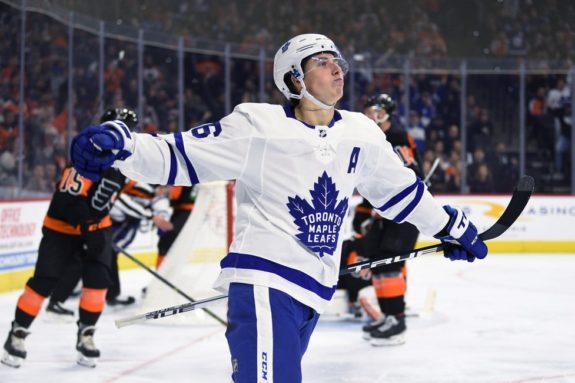With the Toronto Maple Leafs not playing until Wednesday against the Montreal Canadiens, I thought it might be a good time to explore some ideas I’ve been considering for a while now but haven’t had a chance to engage. In today’s post, I want to offer a perspective about the 2020-21 Maple Leafs’ team and suggest what I believe have been the foundational principles core to its construction.
Although I’ve been considering these ideas for some time, they came to the forefront when I was writing about Zach Hyman’s next contract with the Maple Leafs. If you’ve read that post, you’ll know I’m a Hyman fan and believe he should be seen as a core team member.

Hyman’s exactly the kind of player this team was built around. That belief made further sense when I saw the trade-deadline player that general manager Kyle Dubas brought to the Maple Leafs – Nick Foligno.
Three Foundational Principles
As I’ve looked at how the Maple Leafs set out to construct the team’s roster, I believe three foundational principles have been utilized to build this team.
Foundational Principle #1: Develop and Retain a Core of Young NHL Stars
Foundational Principle #2: Build Around Hockey Players Who Represent the “Right” Ethos for the Organization
Foundational Principle #3: Attract High-Quality Veterans Who Still Crave a Stanley Cup
Foundational Principle #1: Develop and Retain a Core of Young NHL Stars
The Maple Leafs got extremely fortunate when they won the 2016 draft lottery. They used that draft pick Auston Matthews first overall choice in that year’s NHL Entry Draft. In previous drafts, they chose William Nylander eighth overall in the 2014 NHL Entry Draft. The next year they drafted Mitch Marner fourth overall in the 2015 NHL Entry Draft. All three became crucial members of the roster.

These three young stars have become the core of the team’s future, and general manager Dubas has been consistent in paying them well and ensuring they signed with the team through the foreseeable future.
Related: Assessing Kyle Dubas’ 2 Years as the Maple Leafs General Manager
Include in that group core player John Tavares, who signed a seven-year, $77 million contract with the Maple Leafs on July 1, 2018. Tavares had been a star with and captain of the New York Islanders, but had grown up in Toronto and had dreamed about playing for the Maple Leafs. With Tavares signing, and signing Nylander ($6,962,366), Matthews ($11,640,250), and Marner ($10,903,000) after their entry-level contracts, that gave the Maple Leafs four players at $40.5 million on an $81.5 million flat salary-cap upper limit.
Investing so heavily in this core group was seen by outsiders as both insanity and pragmatically a detriment to the organization’s ability to build a winning team. Hockey writers and fans believed it was impossible to have four players signed for just under half the total salary cap. In fact, endless debates ensued about which core player would have to go – most chose Nylander.
However, as it turned out, Dubas’ logic was impeccable – although I’m not sure he realized it at the time. Building this solid core ensured that the team retained the nucleus for greatness for the future. With this core, the Maple Leafs would be a strong team every season and would attract other players to join.
When other NHL players looked at what was happening in Toronto, they decided the Maple Leafs had as good a chance as any NHL team to make a postseason run. Dubas also learned that players would sign in Toronto because they believed the team could win a Stanley Cup every season. Whether Dubas or Shanahan knew it at the time of not, NHL veterans would line up to play for the Maple Leafs and do so cheaply.
As I see it, foundational principle one was to develop a core of young players, sign them for an extended time, and build a strong team around them. Nylander came first; Marner second; and Matthews third. When the team signed Tavares, that became a core group that attracted other players.
Foundational Principle #2: Find Hockey Players Who Represent the Values of the Organization
A second foundational principle was to sign the RIGHT kind of player. Perhaps that was part of the plan all along, but recently the Maple Leafs have actively traded for particular “types” of player. The Maple Leafs obviously love speed, skill, and determination (Nick Robertson); but, also notice how many players Dubas signs that come from university backgrounds (Alex Kerfoot and Jimmy Vesey are Harvard grads).
However, the Maple Leafs “kind” of a player is represented redundantly by players such as Tavares, Hyman, Wayne Simmonds, Joe Thornton, Jason Spezza, Morgan Rielly, and others – solid players and class acts. These are strong, ethical, selfless, community-minded players.

This foundational principle became evident when the organization went all-in at the deadline and traded for the best player it could find that would help the organization make an extended Stanley Cup run. They brought in Nick Foligno. [In 2017, Foligno won both the The Mark Messier Leadership Award (the NHL award that recognizes players who are superior leaders within their sport and contributing members of society) and The King Clancy Award (the NHL award given to the player who best exemplifies leadership qualities on and off the ice and who’s made significant humanitarian contributions to his community).
Foligno’s choice represents the Maple Leafs’ belief about the kind of player it wants as part of its team culture and roster. For example, as it turned out the team might have more cheaply brought in former NHL MVP Taylor Hall from the Buffalo Sabres, but they didn’t. Instead, they went for Foligno.
Related: Maple Leafs’ Forgotten Ones: Mikael Renberg
Because many believe Foligno will return to the Columbus Blue Jackets next season, the organization might have used salary-cap magic to bring in Hall without giving up a coveted first-round draft. But it didn’t because, I believe they saw Foligno more than Hall as the right player for this team.
The second foundational principle upon which this team has been built is that the players must be the type of player the team wants – a choice represented by Hyman, Tavares, Rielly, Foligno, and others.
Foundational Principle #3: Attract Veterans Who Crave a Stanley Cup
I believe Jason Spezza represents a more recent breakthrough in the organization’s thinking. Given the organization’s total commitment (including financial) to its core players, after a poor final season with the Dallas Stars 2018-19, when Spezza became a UFA Dubas pick up the veteran as he had picked up UFA Tyler Ennis the season before (in July 2018).
Spezza’s disappointing season was based on what he brought to Dallas in terms of “bang on the buck.” But Dubas believed Spezza could contribute as a player, just that his previous contract was out-of-line with his production. But, at the right price, he had much to offer. Dubas signed Spezza to a $700,000 one-year contract.

Spezza produced similar with the Maple Leafs as he had with the Stars, but at a fraction of the salary-cap hit. After the 2019-20 season, when Spezza proactively let it be known that he’d like to return to the Maple Leafs for the 2020-21 season, Dubas agreed and noted:
“(Spezza) has been excellent with our young players, great experience, works his butt off every single day in the facility and has just been outstanding and an outstanding addition for us.”
Dubas added, “Just his work ethic, his passion for the game, and the fact that he desperately wants to win for obvious reasons… We’re fortunate to have him and have him around here for another season.”
Then Dubas expanded his search for more players who carried Spezza’s pedigree and ethos. As a result, the 2020-21 Maple Leafs’ roster now includes Jason Spezza, Joe Thornton, Wayne Simmonds, and Zach Bogosian. I might be wrong, but I don’t believe that when the organization signed Spezza in 2019 to his first one-year NHL league minimum contract in 2019 the plan had been fully conceived.
That’s why I believe Spezza’s been a crucial addition to this season’s team. He was the first of what I believe will be a lineup of NHL veterans who desire one last chance with the Maple Leafs to compete for the Stanley Cup.
For the Maple Leafs’ organization, these players address three key issues: (a) How can the team fill roster spots cheaply? (b) How can the team find the kind of players with leadership, skill, and desire that would both fit in and contribute in role positions to help the team complete for a Stanley Cup? and (c) How can the organization develop a core of young prospects who are taught how to play the game by the team’s veteran players?
The Team That Dubas and Shanahan Have Created
Insofar as I can tell, the 2020-21 version of the Maple Leafs hockey team has been created by employing three foundational principles.
The first principle I believe has been present since Shanahan took over leadership. Draft, trade for, and develop a core of high-quality prospects and sign them for extended periods of time so they stay with the team. (Nylander, Marner, and Matthews)
The principle I believe came a close second was to build around those players who brought character to the team. (Tavares, Hyman, and Rielly)
Related: Maple Leafs’ Trade Scenarios: Two Crucial Tipping Points
The third principle I believe became viable during Spezza’s first season with the team. That was to bring in NHL veterans desperate to win a Stanley Cup, who were not in it for the money, and who would sign bargain contracts for that chance.
In this, the Maple Leafs have been fortunate that Simmonds and Spezza are from Toronto and want to play here. I believe this third principle will be played out redundantly with the Maple Leafs in years to come.
Here’s hoping that Stanley Cup dream comes true for the entire team but especially for Thornton, Spezza, and Simmonds.